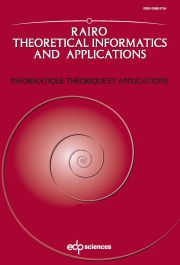Article contents
A Generalized Model of PAC Learning and itsApplicability
Published online by Cambridge University Press: 09 April 2014
Abstract
We combine a new data model, where the random classification is subjected to rather weakrestrictions which in turn are based on the Mammen−Tsybakov [E. Mammen and A.B. Tsybakov,Ann. Statis. 27 (1999) 1808–1829; A.B. Tsybakov,Ann. Statis. 32 (2004) 135–166.] small margin conditions,and the statistical query (SQ) model due to Kearns [M.J. Kearns, J. ACM45 (1998) 983–1006] to what we refer to as PAC + SQ model. We generalize the classconditional constant noise (CCCN) model introduced by Decatur [S.E. Decatur, inICML ’97: Proc. of the Fourteenth Int. Conf. on Machine Learn. MorganKaufmann Publishers Inc. San Francisco, CA, USA (1997) 83–91] to the noise modelorthogonal to a set of query functions. We show that every polynomial time PAC + SQ learning algorithm can beefficiently simulated provided that the random noise rate is orthogonal to the queryfunctions used by the algorithm given the target concept. Furthermore, we extend theconstant-partition classification noise (CPCN) model due to Decatur [S.E. Decatur, inICML ’97: Proc. of the Fourteenth Int. Conf. on Machine Learn. MorganKaufmann Publishers Inc. San Francisco, CA, USA (1997) 83–91] to what we call theconstant-partition piecewise orthogonal (CPPO) noise model. We show how statisticalqueries can be simulated in the CPPO scenario, given the partition is known to thelearner. We show how to practically use PAC +SQ simulators in the noise model orthogonal to the query space bypresenting two examples from bioinformatics and software engineering. This way, wedemonstrate that our new noise model is realistic.
Keywords
- Type
- Research Article
- Information
- Copyright
- © EDP Sciences 2014
References
- 2
- Cited by


